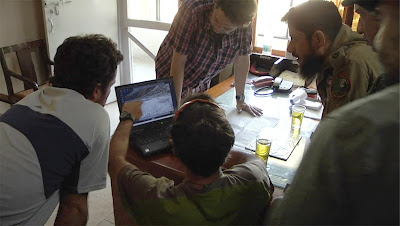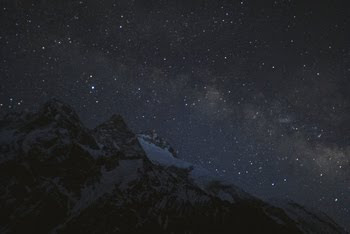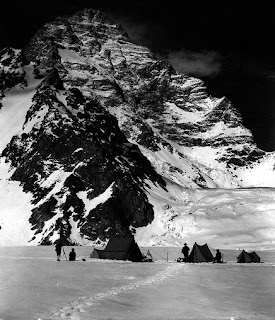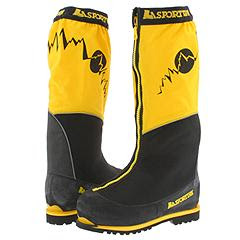A lot has happened since my last post. Most significantly, everyone tried to reach the summit on August 4th. On August 1st everyone in our group left for Camp 2 on the Cesen while many teams left for Camp 2 on the Abruzzi. I decided not to try for the summit. This trip came up rather last minute for me and with filming as my primary goal, I was satisfied having gone to 7,100 meters (23,430 feet). So Chris Szymiec and I stayed down in base camp where we coordinated communications among all the members on the hill. On August 2nd the team went to Camp 3 and on the 3rd they attempted to move to Camp 4 at 7,950 meters (26,083 feet). With little rope fixed between Camps 3 and 4, everyone had to carry big loads, a difficult task at that height. Each member had to carry their personal gear, tents, stoves and importantly, oxygen. These huge loads meant that most people turned around. Only Fabrizio and two team members made it to Camp 4. Early on the morning of August 4th Fabrizio and Gerlinde went for the summit, while the two team members who made it to Camp 4 decided to stay put. Members from the Abruzzi teams joined them and everyone made their way into the bottleneck around 8,200 meters (26,903 feet), a narrow snow slope below a massive serac. I don't know much else at the moment because I ended up leaving basecamp the morning of the 4th. But I do know that no one made the summit that day.
Dealing with HAPEOn the morning of the 4th a Pakistani staff member from another expedition came into our camp and told us that someone was sick. A cook, Ali, had walked into their basecamp the day before and during the night he'd had trouble breathing.
As Chris and I prepared to go check him out we saw two people half carrying, half dragging him down the glacier to us. He was literally blue. He was breathing desperately, with loud wheezing. With a
pulse oximeter we determined that his blood oxygen saturation was only 46% (normal saturation is around 95%) with a resting pulse of 140. It was classic
High Altitude Pulmonary Edema.
For those unfamiliar with it, HAPE is one of those nasty things that can happen to people at high altitude. As the amount of oxygen in the lungs decreases the body constricts pulmonary arteries which in turn increases pulmonary arterial pressure. In susceptible individuals, or those that have traveled to high altitude too quickly, this increase in arterial pressure can lead to the leaking of fluid from blood vessels into the interstitial spaces around the lung and eventually, into the lungs themselves. Patients suffering from HAPE are literally drowning in their own fluids.
Lucky for Ali, we had what we needed to treat him. Left alone, he would have died within about 24 hours. But we were able to put him on oxygen, give him some drugs and put him inside our
Gamow bag, a portable hyperbaric chamber that allowed us to effectively lower his elevation several thousand feet. In the long term, descent to a lower altitude is the only thing that will save a patient with HAPE. But a Gamow bag can mimic this for short periods of time. When Ali arrived at our camp he could not stand, was barely conscious and looked terrible. After one hour in the Gamow bag and on oxygen he was able to walk with the assistance of two people.
We kept the oxygen mask on him and began walking him down the glacier towards Concordia, about 400 meters (1,312 feet) lower. I quickly packed a bag and one of our team memebrs, Matt Gardiner decided to come with me. It was the two of us and about six Pakistani staff from different groups. It was really great to see them pulling together to help one of their brothers. Ali stumbled down the glacier while two guys held him up from either side. They all took turns doing this or holding the bottle of oxygen that was keeping him going. As a group we had two more bottles of oxygen, a stretcher and the Gamow bag with us. I also carried my stethoscope, blood pressure cuff and a selection of drugs in case things got worse.
In Concordia I tried taking him off oxygen to see if the reduction in altitude was helping. His oxygen saturation plummeted and it was clear we had not descended far enough. So we kept going and twelve hours after we left, we had gone down a total of about 600 meters (1,969 feet). This made the difference. Ali was able to sleep without oxygen that night. The next day we kept him on oxygen most of the day (mostly because he was exhausted) and walked another twelve hours. This made a huge difference and suddenly he was like another person, smiling and thanking us for saving his life. On the third day we walked the remaining distance to Askole. 100 kilometers (62 miles) in three days in what is now the middle of Summer. It was pretty miserable at times.
On the fourth day we took a Jeep from Askole back to Skardu where I sit now awaiting the arrival of everyone from basecamp. Ali has thanked us profusely, we've been thanked on behalf of his wife and children, the head of his agency came and thanked us and most importantly, Allah has been thanked. Ali bought us both hats as presents.
Production Almost OverI ran out of battery power on the way down with Ali, but all in all I think I've gotten most of the shots I've wanted. Now that I'm back in a city I can properly charge things and will be concentrating on picking up some last interviews and b-roll here in Skardu. In a few days we'll be back in Islamabad where I have some more b-roll to shoot. After that I'm done really. I'll be back in the United States on the 17th and look forward to the editing process.


















